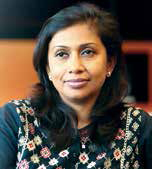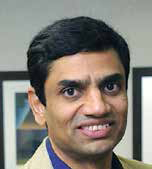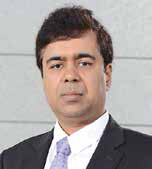Issue No.14 / September 16-30,2015

As the business world is rapidly evolving, global level organisations are posing challenges of integration, inclusion and culture. Additionally, the need for simplifying the work environment through technological interventions is increasing the pressure on human resource teams to reinvent processes. Leadership and talent management continue to be an ever-evolving challenge. The year 2015, in many ways, is being seen as a critical year for organisations to fill the gaps in business needs or to suffer losses as the modern business environment gets ahead.
The ‘new world of work’ requires modifications in business strategies. With barriers between work and life reduced, thanks to social platforms available on mobile phones, organisations are connected to their employees 24x7. Behavioural insights about employees and leadership are now available at the click of a screen, making them partners in the professional journey. Increasing number of multi-national teams, working through virtual collaborations, along with additional contractual workers, is making talent management an uphill challenge for organisations.
Demographic changes, such as those due to the incorporation of millennials in the work force are altering the behaviour of organisations. They expect responsibility with flexibility, freedom with faith. Hence, HR teams need to display innovative thinking. They need to be responsive and proactive. And they have to take the lead in reinforcing the company culture and values so that they bind the truly talented to the organisation for a long time.
CHROs from leading organisations took centre stage at the NHRD’s 3rd Human Capital Conclave 2015 to discuss the incoming transformation. The panel discussion was chaired by Sidharth Tuli, Vice President & Head HR, Hydrocarbon IC, Larsen & Toubro Ltd. The distinguished panel included Sanjay Jorapur, CHRO, Hero MotoCorp Ltd, Krish Shankar, Head HR, Indian Sub- Continent, Philips India Pvt. Ltd, and Anuranjita Kumar, Country Human Resource Officer, Citi South Asia.
Employee engagement, leadership, gamification, big data, and talent analytics emerged as some of the top trends that need careful watching this year.
‘Trends are like horses, you need to ride them in the direction that they are going. The genius of investing lies in recognising the power of a trend, rather than catching it on its highs / lows’
On the Human Capital Index Report, India was ranked 100 out of 124 countries. I didn’t want to start on a dismal note, rather an introspective one. We’re a billion plus population, with an increasing rate of literacy, but clearly there’s something amiss. There is a gap because the majority of Indian talent is actually employed in the unorganised sector. Only a minute percentage of people are in the corporate sector
We also have hundreds of thousands of people coming out of campuses every year. But how many of them have the IQ, EQ and JQ (Job Quotient) to work in jobs? Work ethic is another area that needs attention, despite the high commitment Indians show towards their work. In today’s business environment, agility is important for an organisation. Our environment is ever changing and the culture which we’ve built over the years has to adapt to the ever changing environment. That’s the clear challenge for us as people who work in corporates.
Inclusion is emerging as a favoured theme. Not just from a race perspective, but also from a nationality perspective, for expats. Given the ever-evolving environment, creativity is required, and companies are focussing on ideas as well as execution.
Leadership in my view has to be more integrated today. Gone are the days when a leader could stand there and say follow me and march on. With the new generation, given the ambiguity in the environment, a leader may not have all the answers. So the leader has to know where to get the answers from, rather than coming up with answers himself. There is also going to be a lot of focus on SMAC (Social, Mobile, Analytics, Cloud) Technologies.
Trends are like horses, you need to ride them in the direction that they are going. The genius of investing lies in recognising the power of a trend, rather than catching it on its highs and lows. Trends are like waves - they could build up into Large tsunamis before we recognise when that has happened. The virtual demise of text messaging and Test cricket are examples.
There is a huge demographic change happening in the developed world. While in India we have larger proportions of a younger workforce, in countries like Japan and Europe, the majority of the population is older, working for a longer span of time. I could very well imagine a worker in Germany addressing his co-workers and saying the best is yet to come, after having worked 75 years in the same company. Technological developments have allowed a Delhi doctor to perform a remote surgery on a patient in Ghana. There could be a day when licenses are issued for driver-less cars. There is an interesting example of innovation in education. A non-profit organisation Planet Read is promoting literacy through sub-titling film songs. A staggering 50 per cent of Indian children cannot read and write after five years of primary education. But if children are exposed to just 30 minutes of sub-titles of their favourite songs everyday, the problem of literacy due to improper learning can get solved. This is the power of recognising a trend.
Some HR trends to watch out for are: gamification, big data, and talent analytics, being used for quandaries we face in employee retention, employee engagement and leadership.
Being in this field for the last 30 years, I’ve noticed how leadership has always remained a gap. So, sometimes I wonder, is it really an issue? And, then, I realise that this gap that we keep talking about is a moving target. Things are changing very fast, many Indian companies are going global and many MNCs have forayed into India. Many global companies have Indians at key positions. Then why is there still a leadership gap in India? When you dig deeper, you realise, there are pockets of excellence within India, but there are huge pockets where we are really not doing well.
Another incredible change which is happening is the impact of the digital age. It’s going to change the way most companies work. It’s going to cut out layers and hierarchies very fast. With analytics coming in, the role of the manager and the leader will change. He wouldn’t need to do analysis himself, he will need to inspire and motivate people, and negotiate wherever needed. The other things can be automated. Therefore, you will need the kind of leaders who are really inspirational, who are adaptive towards challenges and learn fast. And that’s where the gap is. As HR, our job is to build a foundation that will last us the next five years. It’s difficult in the changing scenario. When I joined Unilever 25 years ago, the structures were very clear. A person joining as an area sales manager would spend two and half years as area sales manager, then three years as brand manager, then decide if he wants to be a regional sales manager or run another brand, and then the career path was very clear. He would know that in fifteen years he would be the brand director or sales director. But now it has dramatically changed. The way companies develop people is changing so fast, we need to come up with different solutions.
The challenge has doubled. One, the kind of leaders we need is different. And two, the context in which they work is changing so fast that past methods used to develop leaders are not effective any more. Unless we come with solutions to these challenges, the leadership gap will continue to be there. Third, we need to bring excellent practices to the pockets in India where we are not doing well.
There are some mega trends that actually impact human capital trends. One is pervasive technology. By 2025, five billion of the world’s population will be connected to the internet by phones. You can imagine the kind of impact that will happen on organisations. The second is globalisation. Organisations now need to have systems, processes and people who are able to work across 24 hours of the day because of teams sitting across countries.
‘Today, large organisations are employing four or five generations of people. Employees want more flexibility, autonomy, and freedom. A neo-nomadic tendency has appeared where people simply like to move on from one profession to another’
The third is in terms of demographics. The world is becoming richer, more prosperous. The GDP is increasing for every single country in the world. Life expectancy has increased, having implications on organisations. Today, large organisations are employing four or five generations of people. Employees are demanding more flexibility, autonomy, and freedom. A neo-nomadic tendency has appeared where people simply like to move on from one profession to another. My young son when asked what he wanted to do after college said he wanted to take a two year break and go around the world. I wasn’t expecting this answer, but then this is how the younger generation thinks. It’s basically exploring what’s out there and trying to go find it.
If you’re appointed as the leader of a new team and you go around and introduce yourself, you don’t need to talk about who you are, what you do, and what your likes and dislikes are, because people already know that through social media. They know your thoughts on issues, your affiliation towards causes. The leader only needs to become inclusive. Bring authenticity as a leader.
There’s a lot of effort going into learning and development; my belief is that focus is needed on learning effectiveness. There’s no point spending a lot of dollars behind training, and not seeing the development of people. So how to imbibe learning across various generations in a highly networked organisation where people’s learning styles are so different is the challenge for HRs.
And the last factor is culture and engagement. This is an area where HRs can make a difference. People today are coming together for the love they have towards a certain profession. How can these communities be engaged internally and externally needs to be thought out. Virtual teams are a reality now. In my organisation, when we are designing a bike, we have teams working in India, Italy and the US. These guys don’t meet often; they meet once in three months. So how do you create an engagement in virtual teams, without the advantage of bringing everyone together through an outbound program? How do you create virtual engagement? Finally, it’s the quality of work and not the quantity that matters today.





Citi stands for change. I’ve been with this bank for over 20 years now, and I feel like I’ve worked for five different companies, across five different continents. During the financial crisis, we thought we might shut down. At that point of time I was working in London. It was a tough period for us because we didn’t know if we would actually make it. There were times where I didn’t know I’ll have my job tomorrow, yet I was getting on with it and doing my work. That’s culture; those are values. There was a day when our stock price crashed.
It started in the morning at $ 15, by the evening it came to about $ two and went further down to 99 cents. At $ two or three, about hundreds of thousands of Citi employees bought the stock. Not because it was cheap but because they believed that the company would ride through. It was a testimony to the leadership of Citi. Finally, we did come out of the crisis. It’s our values that create our brand. But we tided over because somebody had laid those bricks right for us. So, to me, culture is that glue which makes people stay. Culture is the way people start to behave in a certain environment. And, for us, what can be a better testimony than telling you that we have almost survived the biggest crisis of our lifetime because of the great culture that we have?




‘A whole book can be written on how leadership has changed. People develop as leaders by having the right types of experiences’

Another aspect that has remained constant is mentoring. People develop as leaders when they are supported by good mentors who are willing to guide and coach them, especially in the early part of their career.
However, many things have changed. Experimentation on leadership is one of them. Leadership is no longer elitist. Large numbers of people are being trained. The scale of leadership development has changed immensely. Second, many companies are thinking out of the box when it comes to developing specific skill sets in their leaders. For instance, when I was in Unilever Asia, we were working on providing a sense of community to the employees. We organised a program where teams had to spend at least three to four days with various NGOs. That had a profound impact on the teams. So, leadership development has become all about providing different experiences so that people can really use those experiences to change.



Mentors, counsellors, buddies, are an important part of most big organisations. A lot of Gen Y entering the workforce have a sense of impatience and intolerance. I generally don’t indulge youngsters who ask when they will reach the c-suite because it would be answering for instant gratification. I usually tell them what they need to do to get there. Once they know what the path is, they’re able to get there.
Leadership Development Programs also play a huge part. They help us create a sense of awareness.
But what’s very important is what happens after the classroom and how that learning is being applied. So in Citi we follow employees up to six to 12 months after they have attended a Leadership Development Program, and we’ve found a very high success rate of the program.
By Vignesh Shankar